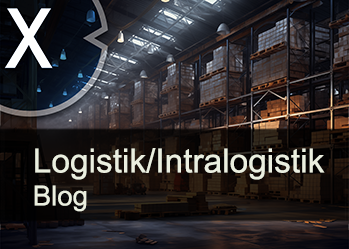Beware of imposters! Port infarction looms! How container high-bay warehouses are revolutionizing port logistics
Xpert pre-release
Language selection 📢
Published on: October 16, 2025 / Updated on: December 1, 2025 – Author: Konrad Wolfenstein

Beware of imposters! Port infarction looms! How container high-bay warehouses are revolutionizing the port chain – Image: Xpert.Digital
The port problem as an obstacle to growth: Why only container imposters can solve the container dilemma
Logistics without limits: Vertically into the future – The new towers of logistics
Container ports today serve as colossal bottlenecks in the global flow of goods. Their importance can hardly be overestimated: around 90 percent of all goods are transported by sea container. The ongoing increase in the loading capacity of container ships – the largest units now hold over 24,000 TEU (Twenty-Foot Equivalent Units) – is ruthlessly revealing the structural weaknesses of port systems. At the same time, this development is creating the expectation that logistical processes at the port must keep pace seamlessly, an expectation that is becoming increasingly difficult to fulfill with existing space potential and methods. Restrictions on the expansion of port areas, conflicts over the use of limited space, and the need to implement innovations in handling mean that efficiently used space becomes a competitive advantage. With construction upwards, heavy-duty logistics promises a logical and urgently needed response to capacity pressures.
Suitable for:
From the quay wall to the bottleneck: Chronicle of a crisis
The development of port logistics follows a history of constant growth and pressure to adapt. Originally, transshipment points between ship and shore were characterized by spaces with a limited degree of automation. The revolution in container transport began in the 1950s when Malcolm McLean introduced the standardized sea container concept, transforming industrial shipping. The rapid increase in ship size and the rise in global import and export volumes fundamentally changed the requirements for port facilities. Ever larger areas were required, but this growth quickly reached its limits – development, geography, environmental protection, and urban competition prevented expansion. While digital processes took hold in container documentation and tracking, transshipment and handling at the pier remained largely analog. Rapid growth, pandemic-related supply chain disruptions, and the lack of further development in intralogistics have led to seaports in Europe and the USA now being considered "under-digitalized." Unions and high wages are hampering change, while supply chains are under increasing pressure.
Vertical instead of horizontal: Functionality and technology of high-bay warehouses
The key innovation of container high-bay warehouses lies in the maximum utilization of available space by stacking steel boxes up to 60 meters high. While conventional storage structures usually only allow six containers to be stacked high, high-bay warehouses enable the stacking height to be tripled or quadrupled, thus drastically increasing handling capacity within the same space. At its core, the system consists of the following mechanism: An automated crane, controlled by intelligent software, picks up containers and places them according to defined criteria. Placement is weight-controlled – heavy boxes move to the bottom, lighter ones to the top. This allows for targeted access to each individual steel box at any time, without time-consuming relocation and manual search work.
Upon arrival, the containers are transported directly to the high-bay warehouse by special autonomous vehicles. Handover takes place via conveyor systems that distribute the boxes to the designated locations. Mathematical optimization based on weight, destination, and turnaround ensures that goods flows are always moved quickly and in a targeted manner. Solutions have also been developed for energy requirements: Solar panels on the roofs provide electricity to power the cranes and feed other processes.
Peak times and performance maximization: the present between persistence and change
In today's container handling industry, conventional warehousing is reaching its limits. The peak loads caused by mass handling—for example, when thousands of containers have to be unloaded from a single ship within a few hours—overwhelm manual labor, conventional cranes, and large-area depots. According to providers, high-bay warehouses increase handling speeds threefold. Significant productivity gains result because containers no longer have to be laboriously retrieved from the stack. The direct access capability of automated systems reduces time expenditure and facilitates the handling of different load types.
At the same time, however, port operators are experiencing resistance to automation. The high earnings of crane operators and drivers, such as those in Hamburg with annual incomes of €100,000 or at US ports with up to $200,000, make these jobs attractive, and unions fear a loss of influence and security for employees. Digital controls and software-based regulation are displacing traditional control methods and fundamentally changing the reality of work in ports. Concrete projects are being discussed, for example in Germany, but practice is still lagging behind.
LTW Solutions
LTW offers its customers not individual components, but integrated complete solutions. Consulting, planning, mechanical and electrotechnical components, control and automation technology, as well as software and service – everything is networked and precisely coordinated.
In-house production of key components is particularly advantageous. This allows for optimal control of quality, supply chains, and interfaces.
LTW stands for reliability, transparency, and collaborative partnership. Loyalty and honesty are firmly anchored in the company's philosophy – a handshake still means something here.
Suitable for:
Space shortage solved: How modular container high racks work – How ports become space-saving and efficient
The imposters in action: Practical examples from logistics innovation
Initial concepts and pilot plants for high-bay container warehouses are already in operation or in advanced planning stages. One example is the Port of Hamburg, which, due to its geographical limitations and competition for space, is discussing innovative solutions such as vertical storage structures. Similar plans are known from the Port of Genoa in Italy. There, several transshipment terminals are clustered close together, and expansion into the hinterland remains virtually impossible, as the city and transport networks cannot provide new space. Vertical expansion is becoming the only practical solution to maintain competitiveness and productivity.
Another example illustrates the technological capabilities: a high-bay warehouse on one hectare of port area can now accommodate around 3,000 containers, three times as many as conventional facilities. Pilot projects for transforming open-plan facilities into vertical container storage are underway in Shanghai, Rotterdam, and Long Beach. The systems used are modular in design; the steel containers are transported autonomously and controlled by software. In some cases, specially developed conveyor vehicles and sorting conveyor systems are also used to ensure optimal distribution and rapid return of the containers.
In addition to large-scale projects, smaller facilities are also being built by specialized industrial companies that organize container flows in the hinterland. Automated storage structures are thus also available to regions and industrial companies that have to manage particularly high throughput rates or seasonal fluctuations.
Suitable for:
- The transformation of an entire infrastructure: high-bay containers, micro-hubs, blockchain, automation and robotics
Innovation and change: The path of container logistics into the future
The logistics industry is facing a structural transformation driven, in addition to increasing ship sizes, by digitalization and automation. Container high-bay warehouses are being touted worldwide as a solution for multi-level bottlenecks at ports. Forecasts assume that several hundred port terminals are suitable for implementation, particularly in regions with strong competition for space and high throughput volumes. Further development of the systems envisages modular, expandable concepts, with increasing integration of artificial intelligence to optimize loading and handling processes.
Fields of innovation are emerging, particularly in the areas of autonomous vehicles for container transport, intelligent software control, and sustainable energy integration. New technical standards and interfaces are promoting global rollout, while research into adaptive mechanisms and resilient logistics systems continues to gain importance. In conjunction with intralogistics, hybrid systems are emerging that combine sea, rail, and road logistics and digitize transport chains end-to-end.
Politically discussed funding programs and international initiatives are facilitating financing and making the transition from conventional to automated systems more attractive. With a view to environmental and sustainability goals, high-bay warehouses are also becoming increasingly relevant from an ecological perspective: space consumption is decreasing, energy efficiency is increasing, and the ecological footprint can be optimized through targeted measures.
Value and limitations of “impostor” logistics
High-bay container warehouses are on the verge of transitioning from innovation to industrial application. Their potential to overcome the previously unsolved capacity problems at seaports and increase the flexibility of global supply chains is compelling in many areas of heavy-duty logistics. The targeted utilization of vertical space, the use of autonomous technology, and intelligent software-supported control are setting new standards in container handling – worldwide.
Nevertheless, the downsides should not be ignored: The high investments, technological risks, and potential for social conflict require a balanced approach to innovation. The acceptance of the ideas by the workforce, unions, and local politicians will determine whether the restructuring of port logistics can succeed.
The future of global goods supply lies in improving handling at the interfaces of logistics. High-bay container warehouses are a crucial building block on the path to high-performance, flexible, and sustainable supply chains. No other innovation addresses the combination of space constraints, automation potential, and increased efficiency as consistently as these "high-flyers" of logistics. Whether they become the new norm or remain the preserve of pioneering ports will be decided at the interfaces of technology, politics, and society. The challenge is enormous, the opportunities unique.
Suitable for:
Advice - planning - implementation
I would be happy to serve as your personal advisor.
Head of Business Development
Advice - planning - implementation
I would be happy to serve as your personal advisor.
contact me under Wolfenstein ∂ Xpert.digital
call me under +49 89 674 804 (Munich)
Our global industry and economic expertise in business development, sales and marketing

Our global industry and business expertise in business development, sales and marketing - Image: Xpert.Digital
Industry focus: B2B, digitalization (from AI to XR), mechanical engineering, logistics, renewable energies and industry
More about it here:
A topic hub with insights and expertise:
- Knowledge platform on the global and regional economy, innovation and industry-specific trends
- Collection of analyses, impulses and background information from our focus areas
- A place for expertise and information on current developments in business and technology
- Topic hub for companies that want to learn about markets, digitalization and industry innovations



























